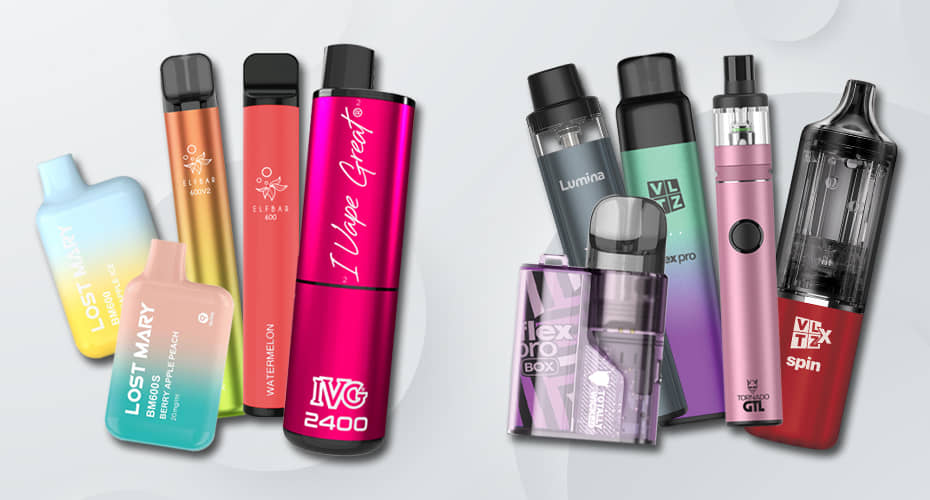Disposable vapes have become a popular trend due to their convenience and ease of use, but what about their impact on the environment? Almost five million disposable vapes per week were littered or discarded in the UK in 2023, nearly four times as many as in the previous year. These disposable devices are made up of plastic, non-rechargeable lithium-ion batteries, and e-liquid containing nicotine in a wasteful package that poses environmental and health hazards. https://vapewholesalepoint.co.uk/product-category/disposable-vape-alternative/
Environmental Cost of Disposable Vapes
1. E-Waste and Plastic Pollution
Disposable vapes are also made of plastic casings that generate litter or end up in landfills. When thrown into open areas or the general waste bins, they end up creating a form of visual pollution and can cause microplastics over time. The plastic shells break down at a very slow rate, forming small bits of plastic that enter the soil and waterways, which puts the ecosystems and wildlife at risk.
2. Dangerous Chemical Dripping
Lithium-ion batteries and electronic components containing heavy metals such as cobalt, copper, nickel, and lead are included in disposables. These chemicals end up in groundwater and waterways when not disposed of properly. Nicotine salts are also present in the rest of the e-liquids, which pollute the environment. These are toxic compounds that are hazardous to aquatic organisms and can bioaccumulate and affect larger food webs.
3. Fire Hazard Battery
Disposable vapes have lithium-ion batteries that, as well as being an overall fire risk, can cause serious injury to those involved in disposal, should the battery become damaged. Crushed or punctured vape batteries are causing more fires on waste collection vehicles and in recycling facilities. In the UK alone, lithium-ion batteries contribute to about 48 per cent of all waste fires that have put municipalities across the country at millions of dollars in damages, not to mention putting people under the threat of safety and resulting in greenhouse gases. These fires might also lead to air pollution spiking at a local level, leading to elevated risks to health.
4. Recycling Challenges
Recycling of disposable vapes is not typical, even though the raw materials used to make the product contain precious materials such as rare earth metals. Their small, compact structure necessitates that the product be torn apart by hand after use to separate metals, plastics, and batteries, which makes it incredibly burdensome to recycle and expensive, as it costs between 0.40 and 1 pound (or more) to do it. As a result, approximately 1 per cent of disposables are recycled. In contrast, the others go to the landfill and are burned, which adds to the loss of recoverable resources and further damages the environment.
5. Magnitude of the Problem
The popularity of disposable vapes has exploded, with an estimated 8.2 million produced per week in the UK. A significant amount of waste and improper disposal increase the environmental load, making it challenging to manage the waste. That disposables sold in the UK alone contain about as much lithium as the batteries in something like 1,200 electric cars, when most of what is in the disposables is not made use of.
Safety: Reusable Pod Kits and Rechargeables
A reusable pod kit and rechargeable vapes serve as the most suitable alternatives to disposable vapes, helping to mitigate these environmental impacts. They have several benefits associated with them:
1. Less Waste Production
Reusable kits have a durable device that has a rechargeable battery, with the small pods (refillable and prefilled) used up only. This significantly reduces the volumes of plastic and electronic waste that would otherwise be disposed of with the entire disposable unit.
2. Enjoyed Recycling Capacities
Fewer batteries end up in waste flows because the primary device is kept for an extended period. Other manufacturers of pods design them in a way that allows them to be recycled or returned to stores. Refillable pods also help minimise plastic waste by allowing multiple refills, thereby delaying the disposal of the pods.
3. Cost Effectiveness and User Control
Reusable products offer a cost advantage due to their lower replacement needs. At the same time, refillable pods provide vapers with minimal control over e-liquid brand and nicotine strength, often resulting in reduced packaging waste. Another means of making the change easier is customizable features, which increase satisfaction.
4. Aiding Regulatory Compliance
The leading markets, such as the UK, have imposed an outright proscription on disposable vape sales, with an enforcement period set to commence as of mid-2025 to prevent youth vaping and address environmental harm. Implementing the reusable pod systems at an early stage will assist users in conforming to emerging laws with ease, and by doing so, it will also minimize the usage of products that negatively impact the environment.
Other Environmental Advantages of Using Reusables
Reduced greenhouse gas emissions: Producing new disposables on an ongoing basis necessitates the excavation of virgin materials, and reusables can prolong the life of devices and shorten the production emissions.
Less fire hazard: The fewer batteries that are discarded in a week, the lower the risk of fire occurring in waste due to damage to the lithium-ion battery.
Reduced environmental cleanup expenses: With less litter, local authorities incur lower cleanup expenditures.
Conclusion
Disposable vapes pose significant environmental hazards due to their massive plastic waste output, toxic chemical seepage, combustion, and recycling. Their consumption and disposal have increased to the point that governments have decided to impose a ban, which will start in 2025 and aims to eliminate pollution and harm to citizens.
A viable alternative, such as reusable pod kits, is a solution that will save a tremendous amount of waste, eliminate harmful effects on the environment, and comply with new stringent rules. When moving to rechargeable, refillable or prefilled reusable systems, vapers can maintain convenience and satisfaction at a much more manageable level and lessen their eco-footprint at the same time.
Using disposable pod systems should not only help keep the planet healthy but also align with evolving standards, ensuring the market’s long-term sustainability.



